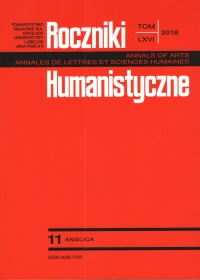Can I Say “Bububu”? Discourse Context and Meaning Construction
Abstrakt
Czy mogę powiedzieć “Bububu”? Kontekst dyskursu a konstrukcja znaczenia
Artykuł analizuje sposób, w jaki kontekst dyskursu oraz cele dialogu wpływają na interpretację. Kontekst dyskursu można określić jako labirynt znaczeń leksykalnych otoczonych splotem informacji kontekstowych (infonów) (cf. Wittgenstein 1958/1986, 8). Niniejsze studium ma na celu „rozplecenie” tych infonów, czemu w praktyce służy dynamiczny model semantyczny ÂeALIS (Alberti and Kleiber 2014). Przeprowadzając wywiad z osobą po operacji chirurgicznej, byłyśmy zainteresowane sposobem, w jaki pacjentka operuje informacjami w rozmowach z lekarzami. Punktem wyjścia dla naszej analizy jest założenie, że wystąpienie problemu pociąga za sobą wyznaczenie celów nakierowanych na jego rozwiązanie. Dyskurs rozpoczyna się wraz z wyznaczeniem celu, a kończy się, gdy cel jest osiągnięty. Dyskurs zazwyczaj składa się z segmentów. Spójność dyskursu zależy od wagi owych segmentów. W przypadku naszego wywiadu segmentami były (kolejne) dialogi składające się na jeden dyskurs, który pacjentka postrzegała jako koherentny. Według wyników naszych badań ÂeALIS pozwala na wyszczególnienie informacji odnoszących się do stanów umysłowych (przekonania, pragnienia, intencje) odpowiedzialnych za spójność dyskursu. Odkryłyśmy, że dyskurs wejdzie w nowy etap dopiero w momencie, gdy — po zakończeniu jednego dialogu — nastąpi zmiana w stanie umysłowym agenta. Ów stan umysłowy jest również zależny od infonów obecnych w kontekście dyskursu, ale niestanowiących części dialogu. Nasza analiza ma na celu pokazanie sposobu, w jaki ReALIS udostępnia zasoby pragmatyczne uczestnikom dyskursu.
Bibliografia
Alberti, Gábor. (2011).ReALIS: Interpretálók a világban, világokazinterpretálóban [Interpreters in the world, worlds in the interpreter]. Budapest, Hungary: Akadémiai Kiadó.
Alberti, Gábor, and Judit Kleiber. 2012. “Where are Possible Worlds? Arguments for ReALIS.” Acta Linguistica Hungarica 59 (1–2): 3–26. https://doi.org/10.1556/ALing.59.2012.1-2.1
Alberti, Gábor, and Judit Kleiber. 2014. “ReALIS: Discourse Representation with a Radically New Ontology.” In Ludmila Veselovská and Markéta Janebová (eds.). Complex Visibles Out There. Olomouc Modern Language Series 4, 513–528. Olomouc, Czech Republic: Palacký University.
Alberti, Gábor, Judit Kleiber, and Eszter Kárpáti. 2017. Reális (ReALIS) kép a másik elméjéről [ReALIS-tic picture of others’ minds]. In Miklós Márton, Gábor Molnár, János Tőzsér (eds.). Más elmék, 237–268. Budapest, Hungary: l’Harmattan.
Asher, Nicholas, and Akex Lascarides. 2003. Logics of Conversation. Cambridge, UK: Cambridge University Press.
Bigi, Sarah. 2016. Communicating (with) care. Amsterdam, Berlin, Washington, DC: IOS Press.
Bruner, Jerome. 1991. “The narrative construction of reality.” Critical Inquiry 18 (Autumn): 1–21. https://doi.org/10.1086/448619. Retrieved from http://www.semiootika.ee/sygiskool/tekstid/bruner.pdf.
Fodor, Jerry A. 1985. “Précis of the modularity of mind.” Behavioral and Brain Sciences 8 (1), 1–42. https://doi.org/10.1017/S0140525X0001921X.
Herman, David. 2013. “Cognitive narratology.” In Peter Hühn, John Pier, Wolf Schmid, and Jörg Schönert (eds.). Living handbook of narratology, 30–43. Hamburg, Germany: Hamburg University. Retrieved from The Living handbook of narratology. Accessed 07.11.2018. http://www.lhn.uni-hamburg.de/article/cognitive-narratology-revised-version-uploaded-22-september-2013.
Kamp, Hans, Josef van Genabith, and Uve Reyle, U. 2011. “Discourse Representation Theory.” In Dov M. Gabbay and Franz Guenthner (eds.). Handbook of Philosophical Logic, 125–394. Berlin, Germany: Springer.
Kárpáti, Eszter. 2015. “Az orvosi nyelvhasználat szerepéről [The role of medical language use].” In: Tamás Gecső and Csilla Sárdi (eds.), Nyelv, kultúra, társadalom, 119–125. KJF, Budapest, Hungary: Székesfehérvár–Tinta.
Kárpáti, Eszter, and Judit Kleiber. 2017. “?Fogalmi ?verbális. Verbálisan rögzített diskurzusok pragmaszemantikai elemzése [?Dictum. Pragmasemantic analysis of verbal discourses].” Officina Textologica 20, 79–89. Debrecen, Hungary: Institute of Hungarian Linguistics, University of Debrecen.
Kecskes, Istvan. 2013. Intercultural communication. Oxford, UK: Oxford University Press.
León, Carlos. 2016. “An architecture of narrative memory.” Biologically Inspired Cognitive Architectures 16: 19–33. https://doi.org/10.1016/j.bica.2016.04.002. Retrieved from https://www.researchgate.net/publication/301756442_An_architecture_of_narrative_memory.
Macagno, Fabrizio, and Sarah Bigi. 2017. “Analyzing the pragmatic structure of dialogues.” Discourse Studies 19 (2): 148–168. https://doi.org/10.1177/1461445617691702.
Pléh, Cs. (1999). “Hozzájárulhatnak-e az empirikus pszichológiai kutatások a nyelv–gondolkodás viszony filozófiai problémájának megoldásához? [Can empirical psychological research contribute to the philosophical problem of language-thinking relationship?].” In Katalin Neumer (ed.). Nyelv, gondolkodás, relativizmus, 35–165. Budapest, Hungary: Osiris.
Sperber, Dan, and Deirdre Wilson. 1995/1986. Relevance. 2nd ed. Cambridge, MA: Blackwell.
Szilas, Nicolas. 2015. “Towards narrative-based knowledge representation in cognitive systems.” In Proceedings of the 6th workshop on computational models of narrative, 133–141. DROPS. Dagstuhl Research Online Publication Server. Accessed 07.11.2018. http://drops.dagstuhl.de/opus/volltexte/2015/5287/pdf/16.pdf.
Wittgenstein, Ludwig. 1958/1986. Philosophical Investigations. Oxford, UK: Blackwell.
Wilson, Deirdre. 2016. “Reassessing the conceptual–procedural distinction.” Lingua 175–176: 5–19. https://doi.org/10.1016/j.lingua.2015.12.005.
Wilson, Deirdre, and Robyn Carston. 2007. “A Unitary Approach to lexical pragmatics: relevance, inference and ad hoc concepts.” In Noel Burton-Robert (ed.). Pragmatics, 230–259. London, UK: Palgrave. https://doi.org/10.1057/978-1-349-73908-0_12.
Copyright (c) 2018 Roczniki Humanistyczne

Utwór dostępny jest na licencji Creative Commons Uznanie autorstwa – Użycie niekomercyjne – Bez utworów zależnych 4.0 Międzynarodowe.





